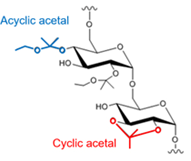
| |
| Names | |
|---|---|
| IUPAC name varies | |
| Other names Ac-DEX, Ace-DEX, modified dextran | |
| Identifiers | |
| ChemSpider |
|
| Properties | |
| Molar mass | varies |
| Appearance | white powder |
| Except where otherwise noted, data are given for materials in their standard state (at 25 °C , 100 kPa). Infobox references | |
Acetalated dextran is a biodegradable polymer based on dextran that has acetal modified hydroxyl groups. After synthesis, the hydrophilic polysaccharide dextran is rendered insoluble in water, but soluble in organic solvents. This allows it to be processed in the same manner as many polyesters, like poly(lactic-co-glycolic acid), through processes like solvent evaporation and emulsion. Acetalated dextran is structurally different from acetylated dextran.
History
Acetalated dextran was first reported in 2008 out of the lab of Jean Fréchet at the University of California, Berkeley in the College of Chemistry. This version of acetalated dextran, often abbreviated Ac-DEX, has dextran and exceedingly low levels of acetone and methanol as degradation products. In 2012, in the laboratory of Kristy Ainslie, at Ohio State University in the College of Pharmacy, polymer synthesis was modified to release ethanol in place of methanol upon degradation. The ethanol producing version of acetalated dextran is often abbreviated Ace-DEX.
Properties

During the synthesis of acetalated dextran both acyclic and cyclic acetals are formed. The acyclic acetals degrade into an acetone and an alcohol, whereas cyclic acetals degrade into acetone. The ratio of cyclic to acyclic acetals varies with reaction time since acyclic acetals are kinetically favored and cyclic acetals are the thermodynamically favored. This unique formation of cyclic and acyclic acetals leads to varying degradation time because the two acetal groups hydrolyze at different rates. Acetalated dextran's degradation time can vary from hours to a month or more at pH 7.2. Also, acetalated dextran is unique because it is acid sensitive. Therefore, at lower pH acetalated dextran degrades more rapidly, which results in a polymer that degrades approximately two logs faster at pH 5 compared to pH 7. The acid-sensitivity of Ac-DEX has illustrated, when formulated into nanoparticles encapsulating a protein antigen, more efficient presentation of antigen to both MHC class I and MHC class II, over other non-acid sensitive polymers like PLGA and non degradable materials like gold nanoparticles.
Applications
Because of the ability of acetalated dextran to degrade more rapidly in low pH environments like the phagolysosome of a macrophage or dendritic cell, it has been used as polymeric micro/nanoparticles. Acetalated dextran was originally developed as a vaccine carrier, but has been used for drug delivery, tissue engineering and infectious disease vaccine delivery. Its unique degradation rates have led to finely tuned release of therapeutic proteins and vaccine elements.
Ac-DEX has also been shown the allow proteins to be stored outside the cold chain.
Formation of nanoparticles with Ac-DEX can be made through standard methods like emulsion, spray drying and electrospray. Using sonication, inorganic nanoparticles have been embedded into Ac-DEX particles to for a composite material for cancer therapy."Prickly Nanoparticles against Cancer". article. Weinheim, Germany. 2017-03-09. Retrieved 2024-09-16. Also they have been used as a core material for cell membrane coating.
References
- ^ Bachelder, EM; Pino, EN; Ainslie, KM (Feb 2017). "Acetalated Dextran: A Tunable and Acid-Labile Biopolymer with Facile Synthesis and a Range of Applications". Chem Rev. 117 (3): 1915–1926. doi:10.1021/acs.chemrev.6b00532. PMID 28032507.
- Bachelder, EM; Beaudette, TT; Broaders, KE; Dashe, J; Fréchet, JM (Aug 2008). "Acetal-derivatized dextran: an acid-responsive biodegradable material for therapeutic applications". Journal of the American Chemical Society. 130 (32): 10494–5. doi:10.1021/ja803947s. PMC 2673804. PMID 18630909.
- Frechet, JM; Bachelder, EM; Beaudette, TT; Broaders, KE. "Acid-Degradable and Bioerodible Modified Polyhydroxylated Materials". Google Patent.
- ^ Kauffman, KJ; Do, C; Sharma, S; Gallovic, MD; Bachelder, EM; Ainslie, KM (Aug 2012). "Synthesis and characterization of acetalated dextran polymer and microparticles with ethanol as a degradation product". ACS Appl Mater Interfaces. 4 (8): 4149–55. doi:10.1021/am3008888. hdl:1811/86186. PMID 22833690.
- ^ Broaders, KE; Cohen, JA; Beaudette, TT; Bachelder, EM; Fréchet, JM (Apr 2009). "Acetalated dextran is a chemically and biologically tunable material for particulate immunotherapy". PNAS. 106 (14): 5497–502. Bibcode:2009PNAS..106.5497B. doi:10.1073/pnas.0901592106. PMC 2666992. PMID 19321415.
- Chen, N; Collier, MA; Gallovic, MD; Sanchez, CC; Fernandes, EQ; Bachelder, EM; Ainslie, KM (Oct 2016). "Degradation of acetalated dextran can be broadly tuned based on cyclic acetal coverage and molecular weight". Int J Pharm. 512 (1): 147–157. doi:10.1016/j.ijpharm.2016.08.031. PMID 27543351.
- Wang, S; Fontana, F; Shahbazi, M-A; Santos, H (2021). "Acetalated dextran based nano- and microparticles: synthesis, fabrication, and therapeutic applications" (PDF). Chem Commun. 57 (35): 4212–4229. doi:10.1039/D1CC00811K.
- Suarez, S; Grover, GN; Braden, RL; Christman, KL; Almutairi, A (2013). "Tunable protein release from acetalated dextran microparticles: a platform for delivery of protein therapeutics to the heart post-MI". Biomacromolecules. 14 (11): 3927–35. doi:10.1021/bm401050j. PMC 3910395. PMID 24053580.
- Chen, N; Gallovic, MD; Tiet, P; Ting, JP; Ainslie, KM; Bachelder, EM (2018). "Investigation of tunable acetalated dextran microparticle platform to optimize M2e-based influenza vaccine efficacy". Journal of Controlled Release. 289: 114–124. doi:10.1016/j.jconrel.2018.09.020. PMC 6365168. PMID 30261204.
- D'Lima, Jessica (4 September 2018). "Stimuli-Responsive Drug Delivery: A New Way To Treat Gout". Advanced Science News. Wiley. Retrieved 31 December 2018.
- Kanthamneni, N; Sharma, S; Meenach, S; Billet, B; Zhao, J; Bachelder, E; Ainslie, K (Jul 2012). "Enhanced stability of horseradish peroxidase encapsulated in acetalated dextran microparticles stored outside cold chain conditions". Int J Pharm. 431 (1–2): 101–10. doi:10.1016/j.ijpharm.2012.04.043. PMID 22548844.
- Wang, S; Fontana, F; Shahbazi, M-A; Santos, H (2021). "Acetalated dextran based nano- and microparticles: synthesis, fabrication, and therapeutic applications" (PDF). Chem Commun. 57 (35): 4212–4229. doi:10.1039/D1CC00811K.
- Jakaria, MJ; Sorkhdini, P; Yang, D; Zhou, Z; Meenach, S (2022). "Lung cell membrane-coated nanoparticles capable of enhanced internalization and translocation in pulmonary epithelial cells". Int J Pharm. 613: 121418. doi:10.1016/j.ijpharm.2021.121418. PMC 8792290. PMID 34954003.